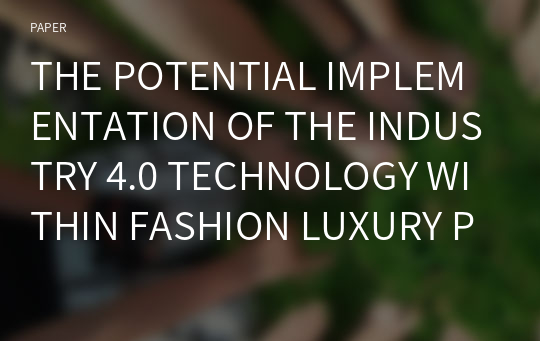THE POTENTIAL IMPLEMENTATION OF THE INDUSTRY 4.0 TECHNOLOGY WITHIN FASHION LUXURY PRODUCTION. OPINIONS FROM A MANAGERIAL POINT OF VIEW AND CUSTOMERS PERCEPTIONS
* 본 문서는 배포용으로 복사 및 편집이 불가합니다.
서지정보
ㆍ발행기관 : 글로벌지식마케팅경영학회(GFMC)
ㆍ수록지정보 : Global Marketing Conference
ㆍ저자명 : Fabrizio Mosca, Emily La Rosa, Chiara Civera, Cecilia Casalegno
ㆍ저자명 : Fabrizio Mosca, Emily La Rosa, Chiara Civera, Cecilia Casalegno
영어 초록
IntroductionThis paper investigates the implementation possibilities of the Industry 4.0 systems within the production of fashion luxury goods by collecting the opinion of the managers and the perception of the potential customers. The results indicate that technologies 4.0 can be implemented within luxury fashion production without affecting the quality of the finished product. However customers are negatively prevented against them. Therefore, giving the present situation of the fashion industry, now more demanding than ever, it would be appropriate to implement such systems without disclosing it to customers.
Theoretical development
With this research we aim to demonstrate that in the world of luxury fashion production there is room, if not the need, to implement the technologies of the Industry 4.0 without affecting the quality of the final product. We believe it is crucial that the luxury environment starts to seriously consider the Industry 4.0 as the former, in recent years, has become ever more challenging. Since luxury has become more accessible to masses, customers are no longer content just by getting the product, they often want it before the general public has it or fully customized to distinguish themselves. This implies a reduction of production times together with multiple rearrangements of the entire production process. Which is why we need to start thinking about Luxury and Industry 4.0. The concept of Industry 4.0 started developing with the exponential involvement of technological means during production processes of any kind. The term describes the model of the “smart” factory of the future where computer-driven systems “monitor physical processes, create a virtual copy of the physical world and make decentralized decisions” based on self-organization mechanisms (Smith, 2016). The goal of the industry 4.0 is to reach a deeper interconnection and cooperation between the available resources and the final customer; it’s a multiple layer engagement composed by complex machines, people, products, information within the production sight and all along the value chain (Tolio, 2016). The implementation of such systems allows achieving better levels of efficiency and contributes to increase the competitive advantage; it is a revolution that involves a company at all levels from the production centers to human resources. Although luxury fashion is a quite peculiar industry, all its processes are still very much cyclical and could benefit from the help of such implementations. The main technologies that are often quoted as being at the core of the Industry 4.0 are IoT (Internet of Things), big data, additive manufacturing, 3D printing, augmented reality and new generation robots. All this may seem too futuristic for an industry such as luxury that has always been associated with craftsmanship. When defining luxury in fact, one of the qualities attributed to this kind of products is the “strong connection with the past proven by the tradition handed down over time” (Dubois, 2001); a description that can be taken quite literally as the heritage of the brand is built upon the traditions passed on by the different artisans who crafted the product. But if we fraction the production process and analyze it in depth, we will see that it is cyclical, and that some of its parts may benefit from such technologies that would make it leaner without affecting the quality of the end product. An example of this can be seen in the laser cutting machines for leather. A robot can cut the elements required to compose a bag in a few minutes, while it would take up to half an hour to do it by hand. Even if mechanically cut though, the bag will still need to be assembled by a highly skilled artisan to become the exceptional quality product that customers expect to see in stores. Many are afraid that technological implementations will lead to the disappearance of the artisanal component failing to understand that the Industry 4.0 is not about complete automation but rather about human-machine interaction. Talking about production we will refer to the process in its integrity, from the sketches to the products in the stores.
Research design
The research was conducted using semi-structured interviews to questiont professionals who work in different stages of luxury fashion production for different companies. All the interviewees were chosen among the industry biggest players: LVMH, Kering, Richemont, Hermès, Chanel and others. To establish the sample of interviewees we divided the production process into four main phases and then identified at least one professional to question for each one of them.
The subdivision we applied was the following:
⦁ Phase 1 - Creation & Design
⦁ Phase 2 - Production & Merchandising
⦁ Phase 3 - Retail & Marketing
⦁ Phase 4 - Supply Chain & Distribution
Each interviewee was asked a set of specific questions related to the complexities of their job and the problems encountered while doing it (Appendix 1). Among the sample there were two professionals that did not belong to the production process but that we deemed necessary to involve to have a more complete outcome. One is a Professor of Fashion design at the Politecnico of Milan, the other is a Strategic Planning Analyst who works for Lectra, one of the biggest companies producing technologies for fashion. In order to investigate the perception of the customers we distributed a multiple choice survey to a heterogeneous sample of 200 people. Among the questions asked one was strictly related to the use of technology while the others regarded arguments, related to its utilization, that emerged while interviewing the professionals. Despite not being directly on the use of technology, we deemed the other queries important to evaluate if the problems emerged from the interviews were relevant also from a customer point of view. The questions submitted via survey were the followings:
1) On a scale of 1 to 4, (1= low interest, 4=high interest) how interested are you in luxury goods?
2) How much worth is being able to buy a luxury good before it is on sale in stores? (1= not worth, 4= very worth)
3) Would you think of higher quality a bag completely handcrafted rather than the very same bag produced also by using industrial processes?
4) Would you attribute a higher value to a luxury product conceived to be respectful for the environment?
The survey ended up highlighting that customers have a negative bias towards the exploitation of such systems within the production of luxury goods. In fact they attribute a higher value to completely handcrafted products, without considering the possibility that the latters may have more defects. The methodology used was successful in helping us understanding the opinion of the management along with the perceptions of the customers. Moreover, through the interviews we were able to highlight practical daily problems encountered by people directly involved in the production process.
Results and conclusion
We used the problems that arose as bases to begin thinking what could be concretely implemented, in which phase and with what goal. We started by focusing our attention on five points that currently challenge production and could be exploited as opportunities for the implementation of specific technology. Nevertheless, we also highlighted three main limits that might prevent the application of said technology. The opportunities of implementation were the following: Production times - Representing one of the biggest problems in the industry, we believe that technology could come to the rescue especially in the first two stages of the process. For example, the use of 3D printing to produce some prototypes or certain components that could be useful for reducing time and costs. Another example is Modaris 3D, a new generation software that allows you to digitize the pattern allowing you to see it in 3D. Exploiting this software would allow to predict the potential problems of the prototype before even crafting it and would help save a lot of time and resources. Not to mention that digitized patterns can be archived and easily reused later. Moreover, the exploitation of the new generation robots to pre-cut certain components would once again allow a shorter production time and reduce costs. Couterfeiting - Another implementation opportunity is represented by counterfeiting. Now that online commerce is booming, the fake industry is at its peak and people find it difficult to distinguish between what is real and what is not. IoT technologies could help immensely with this problem. One of the interviewees working in the distribution phase told us that today when the products are shipped, in order to track them down and recognize them from counterfeits, companies install into their pockets RFID chips, small chips similar to those of credit cards. Their limitation though is that they can be traced or recognized only if scanned. The use of IoT technologies on this type of device (for example, providing the same type of support with a GPS) would allow them to be interactive and serve their purpose even better when the products are shipped all over the world. Sustainability - In recent years the problem of sustainability has become increasingly relevant, to the point that some luxury empires have been built on it, as in the case of Stella McCartney. To pay more attention to the environmental cause, fashion houses could start by wasting less resources. One way to do this could be to use software to optimize pattern placements on fabrics or on leather. Human supervision would still be required, as some pieces need to be cut from specific parts of the leather but it would certainly help in making some useful proposals. Internal communication – Internal communication is a problem at all levels of the production process. It can be an issue especially when it comes to communicating the intentions of the design team to the production and controlling the stock level in real time. In the first case, to solve the problem, we could consider the implementation of a software like PLM (Product Life Management). This type of program helps to follow the transformation from sketches to prototypes to products, providing detailed information on everything that is present on the garment, specifying consumption and costs of materials. With regard to the inventory control problem, we could again use the help of the IoT. Inventory control is a problem both in terms of raw materials (for all those houses that produce prototypes internally) and finished products. In the first case a potential solution could be to label the raw materials with magnetic labels that would allow to see immediately when the components leave the stock. In the second case, as previously mentioned, supplying the finished products with IoT chips would help to locate them and know how many are in stock. Demand forecast – Another major help that industry 4.0 could bring to fashion production is the exploitation of big data to forecast the demand. Nowadays in fact, the constant and hardly predictable changes in fashion heavily affect a demand that already has few reference standards. When it comes to forecast, several factors have an impact on it: trends, social medias, consumption habits etc. The most unpredictable of these factors is probably represented by the social media as clients may cause a peek in demand after seeing a celebrity or an influencer wearing a specific product. Giving all this, it's evident how the more variables we are able to consider when doing forecasts, the better the chances of predicting a scenario close to reality and Big Data would allow to do so. As previously mentioned we also highlighted some limits that could prevent implementation: Costs - The more significant limit when talking about this kind of technology is related to costs. It is important to consider both the ones needed to purchase the technology as well as the ones to train the employees in order to make the implementation possible. As we all know technology is extremely expensive, and in a certain way a form of luxury itself, often being just for few. The size of the brand would modulate of course the amount of the investment in it. Client perception & adverse attitude – The survey pointed out that clients are negatively biased towards technology and, if informed that the product has been realized with the help of technological means, may attribute to it a lower value. What it's necessary to keep in mind though, is that, when taking a survey, you are in front of a screen and not in front of the products. I believe in fact that if a "blind" test was conducted presenting two products of which one completely handcrafted and the other realized by artisans who exploited technological means as well, no one would be able to tell the difference. Training of employees - Another big challenge in the implementation of such systems is the training of the employees. Implementing these technologies for some employees may mean learning again how to do their job with the help of a computer. Being an environment where youngsters are outscored due to the lack of experience, this may represent a problem. In conclusion our research proved that there is indeed room to implement the 4.0 systems as the issues emerged can be partially, if not completely, solved by introducing these technologies making the process leaner and more efficient. Nevertheless, giving the fact that customers are negatively biased towards their use, it would be appropriate avoiding to disclose the information with them.
참고 자료
없음"Global Marketing Conference"의 다른 논문
 THE ROLES OF GREEN PACKAGING IN UGLY FOOD PURCHASE INTE..22페이지
THE ROLES OF GREEN PACKAGING IN UGLY FOOD PURCHASE INTE..22페이지 THE IMPACT OF INDUCED AWE ON ETHICAL TOURIST BEHAVIORS5페이지
THE IMPACT OF INDUCED AWE ON ETHICAL TOURIST BEHAVIORS5페이지 A BIBLIOMETRIC ANALYSIS OF SPIRITUAL TOURISM RESEARCH15페이지
A BIBLIOMETRIC ANALYSIS OF SPIRITUAL TOURISM RESEARCH15페이지 SOCIAL NETWORK ANALYSIS AND RESPONSE TIME TESTING: CONS..11페이지
SOCIAL NETWORK ANALYSIS AND RESPONSE TIME TESTING: CONS..11페이지 THE EFFECTS OF PARA-SOCIAL INTERACTION ON ONLINE CELEBR..3페이지
THE EFFECTS OF PARA-SOCIAL INTERACTION ON ONLINE CELEBR..3페이지 THE INFLUENCE OF OPINION LEADERS ON DAILY DEALS USER’S ..3페이지
THE INFLUENCE OF OPINION LEADERS ON DAILY DEALS USER’S ..3페이지 HOW IMMERSIVE RETAILING AFFECTS CONSUMERS’ URGE TO BUY:..6페이지
HOW IMMERSIVE RETAILING AFFECTS CONSUMERS’ URGE TO BUY:..6페이지 KEY TO SUPERSTARDOM IN A GLOBALISED MARKET: THE ROLE OF..6페이지
KEY TO SUPERSTARDOM IN A GLOBALISED MARKET: THE ROLE OF..6페이지 A POST-PANDEMIC LOOK AT TOURISTS’ PERCEIVED COOLNESS OF..4페이지
A POST-PANDEMIC LOOK AT TOURISTS’ PERCEIVED COOLNESS OF..4페이지 EXTRACTING OFFLINE RETAIL SHOPPING PATTERNS: OLLABORATI..5페이지
EXTRACTING OFFLINE RETAIL SHOPPING PATTERNS: OLLABORATI..5페이지


























